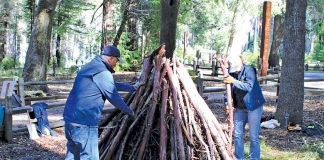We support the San Lorenzo Valley Water District Plan to control Silver Wattle Acacia, French Broom, and Portuguese Broom at the Olympia Wellfield site. We are environmental scientists, each with over 20 years of experience restoring coastal California ecosystems. We consider the proposed methods consistent with best management practices to remove these invasive species, conserve the threatened Santa Cruz sand hills habitat, and minimize risks to water quality.
The Santa Cruz sandhills are a unique plant community restricted to the Zayante sand soils of the Santa Cruz mountains. They host several rare species of plants and animals that only live in this open sandy habitat, including the Mount Hermon June Beetle and Zayante Band-Winged Grasshopper which are protected by the federal endangered species act. The sandhills are threatened by invasive woody species, such as broom and acacia, but removing them is a challenge that requires a carefully crafted, tiered approach. Neither of us advocates herbicides as a first choice. Rather we, like most land managers, support an integrated weed management approach that includes thoughtful consideration of a range of methods to maximize efficacy while minimizing risks to non-target organisms, soil and water quality, worker safety, and the health and safety of watershed residents. In some cases, including the limited use of herbicides allows these multiple goals to be achieved.
The SLVWD plan provides a well-justified and complementary mix of approaches that recognizes the constraints of the ecosystem and the challenge of these noxious weeds. Small invasive plants will be removed by manual methods to minimize herbicide use. Large plants will be controlled by cutting and painting glyphosate directly on the stems. A Qualified Pesticide Applicator License and Personal Protective Equipment is required for these workers. This method is used by land managers throughout California to successfully control broom and acacia while minimizing herbicide use. It is mandatory to apply some herbicide after cutting these species to prevent resprouting. Painting (not spraying) a 50% concentration of the herbicide on the stems means that a minimal amount is used and avoids contact with non-target organisms. Glyphosate will not be applied if rain is forecast, so there is plenty of time for the herbicide to be absorbed by the target plants.
Some people opposed to the project have suggested that the 19,000 large stems could be removed manually. Manual removal would be extremely challenging, given the size of some of the plants, and would cause extensive soil disturbance. This is prohibited by the US Fish and Wildlife Service, since Mount Herman June Beetle larvae, which live a few inches underground, could be killed. Manual removal of large plants may also increase soil erosion and disturb the native seed bank.
Concerns have been raised about glyphosate, since it was recently listed as a ‘probable carcinogen’ by the State of California. The risk from chemicals, however, is determined by both concentration and extent of exposure. The studies cited for this listing were based on exposure to workers who apply the herbicide routinely, not bystanders or people who live in the watershed. We are all exposed to carcinogens regularly, such as soot, solar radiation, and very hot beverages (www.cancer.org/cancer/cancer-causes/general-info/known-and-probable-human-carcinogens.html). We don’t, however, stay indoors all the time to avoid sunlight; we use sunscreen and hats to limit our exposure. Similarly, by applying a small amount of glyphosate directly to the stems, with proper protective gear, the SLVWD plan minimizes risk to people and non-target plants and animals.
We applaud the professional approach the District is taking in land stewardship. If we chose to never use herbicides in the sandhills, then the broom and acacia will spread, and the open, sandy habitat for those rare and endangered species will be lost. Extinction may follow.
Karen Holl is a Professor of Environmental Studies at the University of California, Santa Cruz who conducts research on and teaches about restoring coastal California ecosystems. Bryan Largay is Conservation Director for the Land Trust of Santa Cruz County, and previously worked for the Elkhorn Slough Reserve and the Resource Conservation District.










